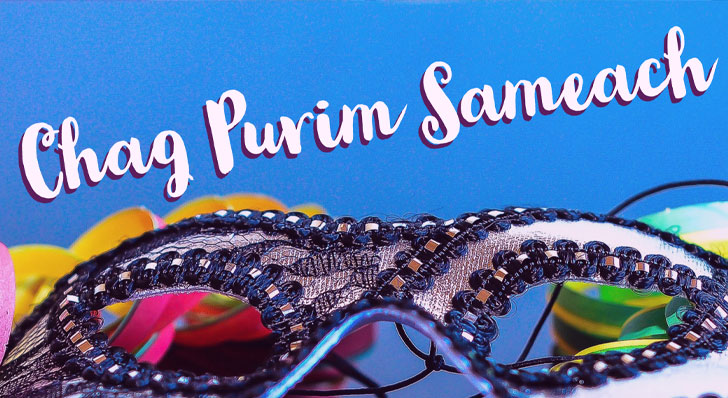
A Few Fun Facts about Purim
Purim is coming! We get to celebrate this wacky holiday by dressing up, making noise, eating triangle shaped cookies, and giving presents and money. In 2023, Purim starts on the night of Monday, March 6 and ends when the sun goes down on Tuesday, March 7.
Here are seven fun facts to get you ready for all the festivities.
- Purim is a mash-up word that literally means lots.
-
You may already know that the word “purim” literally means lots, as in something you cast or draw in order to make a random selection. In this case, Haman (BOOOO!) drew lots in order to choose the date on which he was going to have all the Jews murdered. (In case you forgot, Haman is the bad guy in this story.)
What you might not know is that Purim comes from the Akkadian word pur, the lots which Haman cast. (The Purim story took place in Shushan, Persia, in modern day Iran.) Add on the Hebrew pluralization of -im, and you’ve got yourself a holiday!
- Purim is the first historical account of antisemitism.
-
This is where you might be tempted to point out that Pharaoh and the whole Passover story took place way earlier. And you would be right. But it never actually says that Pharoah, hard-hearted as he was, hated the Jews. (It actually seems more likely that he feared they would one day overpower the Egyptians.) Oh, and the Jews didn’t exist yet; the wandering Israelites didn’t get their commandments and become a religion until after they crossed the Red Sea and headed into the desert. Haman (BOOOO!), however, straight-up hated the Jews just because they were Jews, and wanted to kill them. Not cool, dude. Not cool.
- God isn’t in the Purim Story.
- Some say God wasn’t there at all, some say God was just hidden. Either way, this isn’t a story about God. It’s a story about the courage and faith of two people - Esther and Mordechai.
- Mordecai was the first Jew. Sort of.
-
Speaking of Mordecai - not only is he Esther’s relative (likely her uncle), but he is widely considered to be the first Jew. Sort of. It’s not that he was the first Jewish person, but he’s thought to be the first person in the Bible to be referred to as a Jew (“Yehudi” in Hebrew) rather than an Israelite or Hebrew.
- Haman (BOOO!) was like the original Voldemort.
-
Those of you familiar with the Harry Potter stories know that the evil wizard Voldemort is almost always referred to as “He Who Shall Not Be Named.” Not only do both bad guys exert control through fearmongering, but their names are a real problem. The characters in the Harry Potter stories refuse to say the Dark Lord’s name, while many Jewish communities make as much noise as we can every time Haman’s (BOOOO!) name is mentioned during the traditional reading of the Megillah, or the Book of Esther.
- Public reading of the Megillah: Read - or listen to someone else read - the story of Purim. Be sure to bring your grogger (noisemaker). The louder the better!
- Mishloach manot. This is where you send gifts of at least two portions of food to at least one other person. Just to be clear, you can’t give that gift directly to the lucky recipient; you have to give it to someone else to give to them. Obvi.
- Matanot la’evyonim, or giving money to at least two poor people.
- Se’udat mitzvah, aka PARTY TIME, aka feasting on a yummy meal. The festivities often include a purim spiel, or humorous play about the Purim story!
- It’s a mitzvah to read the Megillah.
-
There are four mitzvot, or commandments /actions associated with Purim, and sadly, dressing up like Queen Esther isn’t actually one of them. (But you can, and should, do it anyway!) The four mitzvot are:
- Purim is the only holiday (that we know of) whose date depends on where you celebrate.
-
Purim falls on the 14th day of the Hebrew month of Adar - unless you live in Jerusalem! That's because Purim isn’t the anniversary of the day the Jews defeated their enemies (that was 13 Adar – in most of the Persian empire). Purim is the anniversary of the day after, when the Jews partied down because they were, you know, still alive! But the fighting continued in the walled city of Shushan through the 14th, and those folks had to wait to celebrate until the 15th. Today, Jews living in Jerusalem (another walled city that dates back to the days of the Purim story) delay their celebration until 15 Adar in honor of the Shushanite Jews’ extra day of battle – and courage!
- We get to eat Haman’s ears. But not in a gross way.
-
Hamantaschen are the triangle cookies filled with something sweet that Jews eat on Purim. Why triangles? It could be that they represent evil Haman’s (BOO!) hat. Alternately, the German word tasche can be translated as “pocket,” and could refer to Haman’s (BOOO!) pockets and the money used to bribe the king so he could try to kill the Jews. Lastly, the Hebrew name for these tasty treats is oznei Haman (BOOO!) which literally translates to Haman’s (BOOO!) ears. Apparently back in the terrible old days, it was customary to cut off a criminal’s ears before his execution. Yikes!
- There are lots of amazing Purim stories for readers of all ages!
-
In addition to the amazing picture books offered through PJ Library, check out these fantastic PJ Our Way Purim titles.
Chag Purim Sameach, everyone! Happy Purim!
